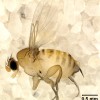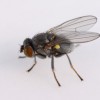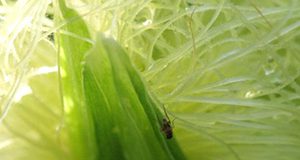Phorid flies (Diptera), also known as humpback flies or scuttle flies for their appearance and behavior, are an extremely diverse group of flies that are saprophagous (feed on decaying organic matter), parasitic, or phytophagous (feed on plants). Within the Phoridae family, the genus Megaselia is also extremely diverse, with more than 1400 described species, many very similar in appearance. The name “cob fly” was given to a Megaselia spp. that attacked corn in Texas. This 5-page fact sheet written by David Owens, Gregg S. Nuessly, Robert Beiriger, and Nicholas Larsen and published by the Department of Entomology and Nematology describes the distribution of this pest, ways to distinguish it from other similar corn ear pests, its life cycle, the damage it causes, and some strategies for management.
http://edis.ifas.ufl.edu/in1144
Tag: Diptera
Zombie Fly (suggested common name) Apocephalus borealis Brues (Insecta: Diptera: Phoridae)
 The zombie fly is primarily a parasitoid of bumble bees and wasps in North America. In 2012, Dr. John Hafernik and his colleagus at San Francisco State University discovered that Apocephalus borealis also parasitizes honey bees. Parasitized honey bees show zombie-like behavior by leaving their hives at night and are often attracted to nearby lights where they show disoriented behavior and die in a few hours. This 5-page fact sheet was written by Nicole A. Casuso, Ashley N. Mortensen, and James D. Ellis, and published by the UF Department of Entomology and Nematology, October 2014. (Photo: Jessica Andrieux, CC SA-BY 2.5)
The zombie fly is primarily a parasitoid of bumble bees and wasps in North America. In 2012, Dr. John Hafernik and his colleagus at San Francisco State University discovered that Apocephalus borealis also parasitizes honey bees. Parasitized honey bees show zombie-like behavior by leaving their hives at night and are often attracted to nearby lights where they show disoriented behavior and die in a few hours. This 5-page fact sheet was written by Nicole A. Casuso, Ashley N. Mortensen, and James D. Ellis, and published by the UF Department of Entomology and Nematology, October 2014. (Photo: Jessica Andrieux, CC SA-BY 2.5)
http://edis.ifas.ufl.edu/in1063
Hydrilla leaf mining flies (unofficial common name) Hydrellia spp. (Insecta: Diptera: Ephydridae)
http://edis.ifas.ufl.edu/in1034 Several native and introduced species of flies in the genus Hydrellia are important because they feed on hydrilla (Hydrilla verticillata L.f. Royle), an invasive aquatic plant that has been classified as a Federal Noxious Weed. Hydrilla has invaded aquatic ecosystems in Florida and across the U.S. Larvae of Hydrellia spp. mine the leaves of hydrilla. In Florida, there are four species that have been associated with the invasive aquatic weed hydrilla: two native species and two species that were introduced for biological control of hydrilla. The native species are Hydrellia bilobifera Cresson and Hydrellia discursa Deonier. The introduced species are Hydrellia pakistanae Deonier and Hydrellia balciunasi Bock. This 6-page fact sheet was written by Emma Weeks and James Cuda, and published by the UF Department of Entomology and Nematology, April 2014.
Several native and introduced species of flies in the genus Hydrellia are important because they feed on hydrilla (Hydrilla verticillata L.f. Royle), an invasive aquatic plant that has been classified as a Federal Noxious Weed. Hydrilla has invaded aquatic ecosystems in Florida and across the U.S. Larvae of Hydrellia spp. mine the leaves of hydrilla. In Florida, there are four species that have been associated with the invasive aquatic weed hydrilla: two native species and two species that were introduced for biological control of hydrilla. The native species are Hydrellia bilobifera Cresson and Hydrellia discursa Deonier. The introduced species are Hydrellia pakistanae Deonier and Hydrellia balciunasi Bock. This 6-page fact sheet was written by Emma Weeks and James Cuda, and published by the UF Department of Entomology and Nematology, April 2014.
